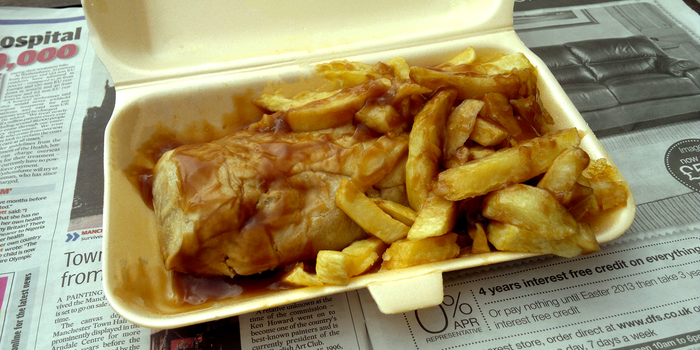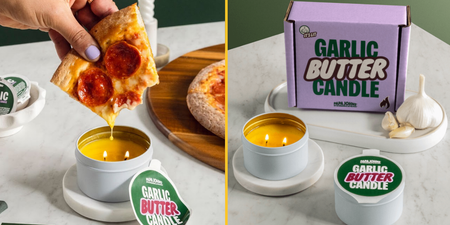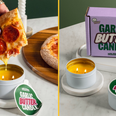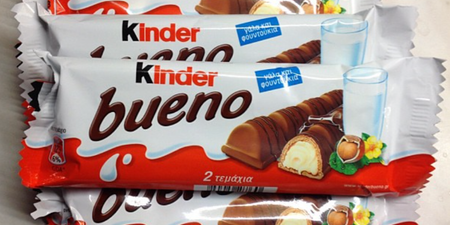From Rag Pudding to the Wigan Kebab, here’s a gastronomic snapshot of northern England
At the bottom of Aberford Road in Woodlesford, south Leeds, just before you reach the Co-op, lies a fish and chip shop like no other. The fish, which is locally sourced and recently caught, is beautifully white and flaky, while the chips, cut thick and chunky, are cooked in beef dripping until they are ever so slightly crispy and have a golden brown hue.
But ask anyone in those parts what the best part of a chippy tea is and they will say, to a man, that it is the scraps. The excess batter, often discarded in chip shops outside the north, creates a crispy layer around every mouthful, adding a hearty dollop of extra indulgence that turns a forkful of chips into a symphony of flavours and textures.
In the years since I have been exiled in the south I think about that Aberford Road chippy almost every time I get served fish and chips cooked in sunflower oil without any scraps on top. The shop doesn’t appear in any guidebooks and has never won any awards, but it’s heads and shoulders better than anything I’ve ever tasted outside Yorkshire.
Related link: New map showing where ‘the north’ begins divides opinion
In many ways, that’s what makes it so good. There’s no pomp or illusions of grandeur. The chips aren’t served in mock deep fat fryer baskets and the staff address you as ‘love’, ‘dear’ or ‘darling’ as you squeeze your way through the snaking queues that pack the front of the terrace house eatery.
That summarises what northern people and, as such, northern cuisine is all about. It’s unfussy. It doesn’t have to look the part. It doesn’t have to be dressed up like it’s going on a night out and there’s no use if it leaves you feeling hungry at the end. So long as it tastes good, fills you up and leaves you with a sense of pride that you’re eating something that’s better here than anywhere else, that’ll do us. And if you’re minded to find out, it might just do you too.
Parmo
Ever since the Conservatives were elected on the back of a surge in support from Red Wall seats in 2019, their plan to ‘level up’ the North of England has been chief and centre of their agenda.
Or so they say. In reality, very little has actually been achieved. Britain’s new railway which was supposed to connect northern cities with London will now go no further than Birmingham for the foreseeable future, and infrastructure projects such as the Northern Powerhouse Rail have been significantly scaled back.
But one thing the new crop of Tory MPs has achieved is to get Parmo – a Middlesbrough delicacy consisting of breaded chicken topped with white béchamel sauce and cheese – on the House of Commons menu thanks to an appeal by Matt Vickers, the Conservative MP for Stockton South, to have it included.
Parmo was first brought to Boro by a chef with the American army who moved to Teesside after he was wounded in France in the 1950s. His son-in-law, Caramello, still lives locally and, as of 2014, was continuing the family’s proud Parmo tradition. But the city is now its true guardian.
As one enthusiast once said, “if the Parmo was a place, I’d like to think it’d be Middlesbrough. No nonsense, hard as nails, no airs and graces.”
Wigan Kebab
There aren’t many people who look at a kebab and conclude that, on balance, it probably isn’t carby enough. But the proprietors of The Trawlerman Fish & Chip Shop in Wigan did just that when they invented the Wigan Kebab, which is basically just a pie (meat and potato, chicken, balti) in a barm (bap, roll, cob).
Indeed, so popular is the carb-loading food staple it even has its own Facebook page, with people sharing their own meals often with a side serving of pea sauce (pey wet), another local staple.
We even gave it a go ourselves:
Salt and Pepper Chips
Outside of London, Liverpool has one of the oldest Chinatowns in the country thanks to its once bustling port that connected the north western city to the rest of the world through a flurry of trading activities.
Today, that heritage is celebrated at the chippy where Salt and Pepper Chips is deemed a must-try for anyone visiting the city.
A mix of onion, green pepper, chilli, salt and other ingredients are used as seasoning. It’s equal parts sweet, savoury and salty, and you can lash it on anything from chicken nuggets to sausage rolls.
Rag Pudding
In the days before ceramic basins, plastic boiling bags and other such cooking utensils, the people of Oldham came up with a more straightforward way of getting their savoury fill by wrapping delicious dollops of minced beef and onion gravy in a suet pastry that was contained within cotton or muslin cloths, creating the now-famous ‘Rag pudding’.
Like many staple working-class meals that took root in the Northern industrial heartlands, it was an easy way of making a little bit of meat go a long way while filling up the hungry mill workers with lots of calories.
Today they remain a common feature in chip shops, pubs and cafes around Oldham, with the Jacksons Farm Fayre factory pumping out an astonishing 800,000 of them a year. Owner Keith Jackson is responsible for the exponential growth, having left a successful job in The City to take over the wholesale butchery business from his dad. You could describe it as a real riches to rags story.
Hull Patties
Competition over the best deep-fried foods is hot in the North of England and even hotter north of that, but Hull has a pretty strong claim in the shape of its native ‘pattie’.
Dating back to the 1800s when they were sold as a cheap alternative to fish patties, the deep-fried snack encompasses mashed potato with sage, creating a jagged, golden exterior that gives way to steaming, soft, herb-speckled inners. Still popular in most fish and chip shops, time was that the women who crafted the snacks were affectionately known as “Pattie Slappers” due to the arduous process of slapping countless discs of potato with salt, pepper, sage, and often onion.
Today it makes for the perfect pre or post-match snack served alongside a mound of chip shop chips doused in salt, vinegar and another local favourite; American chip spice.
Craster Kippers
The walk from Dunstanburgh Castle to Craster in Northumberland is spectacular for two reasons. The first is the views, which stretch across the raggedy coastline and out to sea with nature never far away, and the second is the smell that emanates from L Robson & Sons smokers, a smoky fish smell that meets you head-on with the fresh sea breeze.
Kippers have been smoked in this corner of the North East for generations, giving locals and those who visit a slice of perfection from morning to noon. In the visitor capark a trailer often parks up serving kippers for breakfast in bread buns with a piping hot cup of coffee or tea. Otherwise you can take it away and have one on toast for breakfast with a poached egg on top.
Succulent. smoky and with a warm, golden colour that only comes from at least 14 hour in a Traditional smoke house, there is really nothing better.
Fish and Chips with Scraps
Fish and Chips are done differently in the north.
Unlike most place down south, the fish and chips is cooked in beef dripping, rather than sunflower oil, which makes it a far tastier overall experience. What’s more, they serve it with scraps, which are the little bits of batter that often get discarded outside of the north.
For the best fish and chips – aside from in south Leeds – give Grimbsby a try or Scarborough in Yorkshire. Seahouses in the North East is also worth a go, although rumour has it they charge a quid for their scraps up there. Scandalous!
Eccles Cake with Lancashire Cheese
Rivalries aren’t hard to come by in Manchester, but few are as fierce as the feud between two of the Eccles cake’s earliest purveyors, James Birch and James Bradburn.
Spotting a market for the sweet treats, which comprise of flaky pastry filled with dried currants, candied lemon, orange zest, sugar and spices, Birch opened a shop opposite Eccles Parish Church in 1796 and was soon in a position to upscale, moving to larger premises across the road. To avoid confusion, he erected a sign that read “Eccles Cake Makers Removed from across the way” on the building, which still stands today.
But when he moved, Bradburn, a former employee of his, had the shop rebuilt and installed a sign which certainly didn’t sugarcoat his intentions, if you’ll excuse the pun. “Original and Oldest Established Eccles Cake Shop, Never Removed”, it read, and so the feud began.
Today there is only one prominent bakery still producing the cakes in Eccles, run by the Edmonds family since the 1930s. But even they are not without their rivalries. In 2004 Greggs decided to drop the cakes from all its 1,200 shops, even the branch on the same street where Birch first peddled his wares at the end of the 18th century. Talk about being caster-side!
Enjoy these with a wedge of Lancashire Cheese. It does down a treat!
Bury Black Pudding
There are only two places in the whole of the United Kingdom that you should consider buying you black pudding from; Stornoway, in Lewis and Harris in Scotland, and Bury, in Greater Manchester.
Black pudding first arrived in the UK via European monks, who named the product ‘blutwurst’ which translates to ‘Blood Sausage’.
They first visited Yorkshire before making the trip over the Pennines to settle in Lancashire where this wonderful product became known as “Black Pudding”.
Ever since then, black puddings have been promoted as a tasty, wholesome food. The profile and popularity of black puddings has gone from strength to strength, and today they can be seen on the menus of top class restaurants all over the country.
Morecambe Shrimp
For hundreds of years the channels, gutters and dykes of Morecambe Bay have provided locals with a plentiful supply of one of Britain’s most loved shellfish; shrimp.
Traditionally fished using a hand net in shallow waters the use of horses, tractors and eventually purpose-built boats called “nobbies” were brought in to open up the bountiful catches that lay in the deeper channels. During the 1930s, the industry exploded as Morecambe Bay shrimp – delivered in neat little china pots – became popular among the fashionable tea tables of the London elite.
Today only a handful of shrimp trawlers remain in the area manned by a dying breed of people with local knowledge of the shifting quicksand and tidal patterns in the area. But bolstered by programs such as The Ark of Taste and Booths’ Forgotten Foods project, which seek to protect endangered products, there could be a mini-revival in sight, with sales on the rise once again.
Extracts taken from The Great Pie Revolt: A Gastronomic Guide to the Football League
Related links:
- Curry sauce beats gravy in the battle of the greatest chippy sauce
- Hellmann’s release ‘smart jar’ that tells you if your fridge is too warm
- Billboard goes up in flames outside Burger King to tease new collaboration
- McDonald’s raises price of five menu items today – here’s the full list





















































